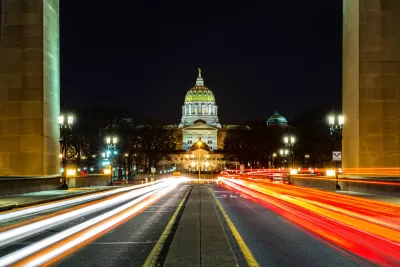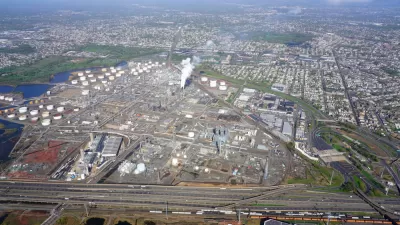Pennsylvania is the nation’s #2 natural gas producer, #3 in coal, and #4 in carbon emissions. Gov. Tom Wolf issued an executive order on Oct. 3 to initiate the process to join the regional cap-and-trade program, but will the legislature allow it?

"Gov. Tom Wolf on Thursday put Pennsylvania on a long and not entirely clear path to joining the Regional Greenhouse Gas Initiative, a multi-state partnership dedicated to reducing carbon dioxide emissions from power plants over time," writes state government reporter Charles Thompson for The Patriot.
It’s a huge step forward for Pennsylvania in terms of fighting for lower carbon emissions, and it also significantly muscles up the impact the northeastern and mid-Atlantic states could have in the absence of federal leadership on the climate change issue.
“Climate change is the most critical environmental threat confronting the world, and power generation is one of the biggest contributors to greenhouse gas emissions,” said Governor Wolf in his office's press release on Oct. 3 announcing the executive action in which he instructed the Pennsylvania Department of Environmental Protection (DEP) to join the Regional Greenhouse Gas Initiative (RGGI).
By no later than July 31, 2020, develop and present to the Pennsylvania Environmental Quality Board a proposed rulemaking package to abate, control, or limit carbon dioxide emissions from fossil-fuel-fired electric power generators.
While it is not entirely clear if legislation is needed, Virginia's Democratic governor, Ralph Northam, learned in April what a Republican-controlled, tax-averse legislature can do to the best of environmental intentions when they added language in the state budget bill to prevent Virginia from joining RGGI.
Thompson noted that at Thursday's press event in Harrisburg where Wolf signed his executive order, the Democratic governor stated, "We need to make sure that the transition to a cleaner energy mix does not leave workers and communities behind. And it will take buy-in from the Legislature..."
And even if the governor does have the latitude to build the program, some legislative staffers reached this week said they aren’t sure the language in the air pollution law covers implementation of a cap-and-trade program that some might define as pollution tax.
California, which participates in the Western Climate Initiative with Quebec and Nova Scotia, learned the hard way of the importance of legislation when it was sued by the state chamber of commerce over just this issue after its first auction of carbon credits almost seven years ago. When it renewed its cap-and-trade program three years ago, not only did it do so through legislation, proponents made sure it passed with a two-thirds supermajority necessary for tax legislation.
Unlike RGGI, the California cap-and-trade program applies to large electric power plants, large industrial plants, and fuel distributors (e.g., natural gas and petroleum), while RGGI only applies to the power plants.
Thompson adds, "Leaders of the majority Republican caucuses in both the House and Senate let it be known [Sept. 30] that they expect to have a great deal of input in Pennsylvania’s RGGI gameplan - if they decide to support it at all."
Governor eyes auction proceeds for infrastructure purposes
Thompson's piece, a self-described "primer" for PennLive readers on the governor's intentions, is very informative on how cap-and-trade works, and how it's playing in Keystone State politics.
What happens to the auction proceeds?
The dollars the energy producers pay for their allowances - at one credit for each ton of pollution generated - are apportioned back to the participating states according to their share of the total market.
Pennsylvania’s addition alone will account for about 78 million tons of carbon emissions, which is slightly more than all of the current nine RGGI states combined. At the most recent credit prices, that could net the state something more than $300 million per year.
[Note: On January 1, New Jersey "makes ten."]
In an earlier piece, Thompson reported that "administration officials are also promoting how [joining RGGI] could create an alternative funding source for the governor’s $4.5 billion “Restore PA” infrastructure program."
Back to Thompson's primer, which also addresses the question of whether auction proceeds could be used to transportation and broadband investment.
RGGI states are encouraged to use the proceeds to advance their respective energy policy goals or to bolster themselves against the effects of climate change, but Maryland Environment Secretary Ben Grumbles [current chair of the RGGI board] said participating states have broad latitude to make their own investment choices.
Grumbles said other RGGI states thus far have used proceeds for programs including weatherization of buildings; programs to promote the use of more energy-efficient products; building out infrastructure for electric vehicles; and even direct rebates to electric ratepayers.
How quickly does this happen?
As noted in Wolf's executive order, DEP has been "instructed to develop and present to the Pennsylvania Environmental Quality Board a proposed rulemaking package to abate, control, or limit carbon dioxide emissions from fossil-fuel-fired electric power generators no later than July 31, 2020."
Thompson adds:
That would trigger a public comment period, after which a revised and final rule would be developed for further consideration by the state’s Independent Regulatory Review Commission. It would not be a shocker if Pennsylvania’s entry process takes at least as long, if not longer, than New Jersey’s [which will have taken almost two years].
Wolf, at one point Thursday, speculated the process will take two years. “There’s going to be absolutely a Iot of opportunity for people to weigh in,” Wolf said. “I just want to get this thing started. I think we need to start.”
FYI, Wolf’s second term runs through January 2023.
Additional reading: Marianne Lavelle, an environment reporter for InsideClimate News, writes on Oct. 3:
Pennsylvania's move is significant because it would bring the first major fossil fuel producer into the RGGI fold. The state is second only to Texas in natural gas production, and third behind Wyoming and West Virginia in coal. Because RGGI puts a price on carbon in the electricity marketplace, it reduces demand for those fuels—with coal taking the biggest hit at first.
In terms of energy-related carbon dioxide emissions by state, 2016, it was fourth behind Texas, California, and Florida, according to the U.S. Energy Information Administration.
Related in Planetizen:
-
Northeast Cap-and-Trade Agreement Faces Uncertain Future, January 26, 2013
FULL STORY: What is a RGGI? A PennLive primer on Gov. Wolf’s big move on climate change policy

Maui's Vacation Rental Debate Turns Ugly
Verbal attacks, misinformation campaigns and fistfights plague a high-stakes debate to convert thousands of vacation rentals into long-term housing.

Planetizen Federal Action Tracker
A weekly monitor of how Trump’s orders and actions are impacting planners and planning in America.

Chicago’s Ghost Rails
Just beneath the surface of the modern city lie the remnants of its expansive early 20th-century streetcar system.

Bend, Oregon Zoning Reforms Prioritize Small-Scale Housing
The city altered its zoning code to allow multi-family housing and eliminated parking mandates citywide.

Amtrak Cutting Jobs, Funding to High-Speed Rail
The agency plans to cut 10 percent of its workforce and has confirmed it will not fund new high-speed rail projects.

LA Denies Basic Services to Unhoused Residents
The city has repeatedly failed to respond to requests for trash pickup at encampment sites, and eliminated a program that provided mobile showers and toilets.
Urban Design for Planners 1: Software Tools
This six-course series explores essential urban design concepts using open source software and equips planners with the tools they need to participate fully in the urban design process.
Planning for Universal Design
Learn the tools for implementing Universal Design in planning regulations.
planning NEXT
Appalachian Highlands Housing Partners
Mpact (founded as Rail~Volution)
City of Camden Redevelopment Agency
City of Astoria
City of Portland
City of Laramie




























